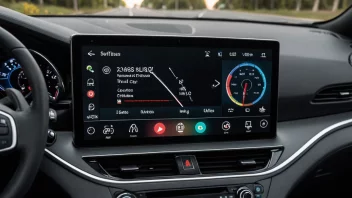As automotive technology continues to advance at a rapid pace, the focus on safety has never been more critical. With the introduction of innovative systems designed to protect not only the occupants of a vehicle but also pedestrians and cyclists, we are witnessing a transformation in how we think about car safety. From advanced driver-assistance systems (ADAS) to autonomous driving capabilities, the evolution of car safety technology is reshaping our roads and enhancing the overall driving experience. In this article, we'll explore the latest developments in automotive safety technology, the impact of these innovations, and what the future may hold for driving.
Understanding Advanced Driver-Assistance Systems (ADAS)
One of the most significant advancements in automotive safety technology is the development of Advanced Driver-Assistance Systems (ADAS). These systems utilize sensors, cameras, and radar to provide drivers with real-time information about their surroundings and assist in various driving tasks. Common features of ADAS include:
- Adaptive Cruise Control: Automatically adjusts a vehicle's speed to maintain a safe distance from the car in front.
- Lane Keeping Assist: Helps drivers stay in their lane by providing steering assistance.
- Automatic Emergency Braking: Detects potential collisions and applies brakes to prevent accidents.
- Blind Spot Monitoring: Alerts drivers to vehicles in their blind spots, helping to prevent lane change accidents.
These features not only enhance driver awareness but also actively contribute to accident prevention, making driving safer for everyone on the road.
The Rise of Autonomous Vehicles
As technology continues to advance, the concept of fully autonomous vehicles is becoming a reality. Companies like Tesla, Waymo, and others are investing heavily in developing self-driving cars equipped with sophisticated sensors and artificial intelligence. Autonomous vehicles aim to reduce human error, which is a leading cause of traffic accidents. Key elements of autonomous vehicle technology include:
- Sensor Fusion: Combining data from various sensors (LiDAR, cameras, radar) to create a comprehensive view of the vehicle's surroundings.
- Machine Learning: Utilizing algorithms to enable vehicles to learn from their environment and improve their decision-making capabilities.
- Vehicle-to-Everything (V2X) Communication: Allowing vehicles to communicate with each other and infrastructure to enhance safety and efficiency.
While fully autonomous vehicles are still in the testing phase, the advancements in this area promise to revolutionize road safety in the years to come.
Enhanced Structural Safety Features
Car manufacturers are also focusing on improving the structural integrity of vehicles to enhance safety. Innovations in materials and design have led to the development of stronger yet lighter vehicles. Some notable advancements include:
- High-Strength Steel: Used in the construction of vehicle frames, this material provides better crash protection while reducing overall weight.
- Crush Zones: Engineered areas of the vehicle that absorb impact energy during a collision, protecting occupants.
- Airbag Technology: Continuous improvements in airbag deployment systems, including side airbags and knee airbags, offer additional protection during accidents.
These advancements in vehicle construction play a crucial role in ensuring that passengers are better protected in the event of a crash.
The Role of Connectivity in Safety
As cars become more connected, the role of technology in enhancing safety continues to grow. Connected vehicles can share information about traffic conditions, weather, and potential hazards with other vehicles and infrastructure. This connectivity allows for improved situational awareness and can help prevent accidents. Some key features of connected vehicle technology include:
- Real-Time Traffic Updates: Providing drivers with information about congested areas and alternative routes.
- Emergency Response Systems: Automatically notifying emergency services in the event of a collision, reducing response times.
- Maintenance Alerts: Sending notifications to drivers regarding potential mechanical issues, helping to prevent breakdowns and accidents.
The integration of connectivity into vehicle safety systems represents a significant leap forward in protecting drivers and passengers alike.
The Future of Car Safety Technology
As we look to the future, the evolution of car safety technology is likely to continue at an accelerated pace. With ongoing advancements in artificial intelligence, machine learning, and sensor technology, we can expect to see even more sophisticated safety features in the coming years. Potential developments may include:
- More Comprehensive ADAS: Expanding the capabilities of existing systems to handle more complex driving situations.
- Fully Autonomous Fleets: The emergence of self-driving taxis and delivery vehicles that can operate safely without human intervention.
- Integration with Smart Cities: Vehicles that can communicate with urban infrastructure to improve traffic flow and safety.
These innovations have the potential to make roads safer than ever, reducing the number of accidents and fatalities.
In summary, the evolution of car safety technology is transforming the automotive landscape in remarkable ways. From advanced driver-assistance systems to autonomous vehicles and enhanced structural features, the focus on safety is more prominent than ever. As technology continues to advance, we can expect even greater innovations that will further protect drivers, passengers, and pedestrians alike. Embracing these advancements not only enhances our driving experience but also contributes to a safer future on the roads.






